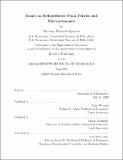| dc.contributor.advisor | Iván Werning and Daron Acemoglu. | en_US |
| dc.contributor.author | Spector, Mariano Eduardo. | en_US |
| dc.contributor.other | Massachusetts Institute of Technology. Department of Economics. | en_US |
| dc.date.accessioned | 2020-09-03T17:43:21Z | |
| dc.date.available | 2020-09-03T17:43:21Z | |
| dc.date.copyright | 2020 | en_US |
| dc.date.issued | 2020 | en_US |
| dc.identifier.uri | https://hdl.handle.net/1721.1/127037 | |
| dc.description | Thesis: Ph. D., Massachusetts Institute of Technology, Department of Economics, May, 2020 | en_US |
| dc.description | Cataloged from the official PDF of thesis. | en_US |
| dc.description | Includes bibliographical references (pages 223-227). | en_US |
| dc.description.abstract | This thesis consists of three chapters. Chapters 1 and 2 study redistributive fiscal policies. Chapter 3 analyzes the role of asymmetric information in frictional labor markets. Fiscal stimulus during the Great Recession consisted mainly of transfers, rather than government purchases. Chapter 1 analyzes the role of marginal propensities to consume (MPCs) in shaping the effect of such policies. I construct a continuous-time New Keynesian model with heterogeneous overlapping generations which allows for arbitrary MPC heterogeneity. I characterize the output multipliers of fiscal transfers, and show that the role of MPCs is mainly to determine the timing of the fiscal stimulus. The relation between this timing and the cumulative effect on output is, however, ambiguous. Indeed, I show that transfers to low-MPC consumers may generate a higher cumulative effect on output. | en_US |
| dc.description.abstract | From a normative perspective, however, there is no ambiguity: with larger differences in MPCs, optimal policy can obtain macro stabilization with smaller welfare losses. In Chapter 2, I analyze redistributive policies when households are heterogeneous with respect to both their MPCs and their risk aversion. I characterize transfer multipliers in a model in which capital is subject to uninsurable idiosyncratic risk. Based on survey data, I assume that MPCs and risk aversion are positively correlated in the population. A redistribution from low-MPC, low-risk aversion households to high-MPC, high-risk aversion households creates two opposing effects: a higher mean MPC tends to stimulate aggregate demand, but an increase in the mean risk aversion tends to depress asset prices, generating a negative income effect on consumption. In Chapter 3, I study a frictional labor market with horizontally differentiated workers. | en_US |
| dc.description.abstract | Firms have incomplete information about the skills of workers who apply to their vacancies. Workers self-insure against unemployment risk by applying to jobs for which their skills are not well suited. This decreases firms' incentives to create vacancies by deteriorating the quality of the average applicant. Workers thus impose a negative externality on each other, which makes the equilibrium inefficient. However, although workers apply to too many jobs, I show that unemployment can be too low or too high. Welfare-improving government policies are considered. | en_US |
| dc.description.statementofresponsibility | by Mariano Eduardo Spector. | en_US |
| dc.format.extent | 227 pages | en_US |
| dc.language.iso | eng | en_US |
| dc.publisher | Massachusetts Institute of Technology | en_US |
| dc.rights | MIT theses may be protected by copyright. Please reuse MIT thesis content according to the MIT Libraries Permissions Policy, which is available through the URL provided. | en_US |
| dc.rights.uri | http://dspace.mit.edu/handle/1721.1/7582 | en_US |
| dc.subject | Economics. | en_US |
| dc.title | Essays on redistributive fiscal policies and macroeconomics | en_US |
| dc.type | Thesis | en_US |
| dc.description.degree | Ph. D. | en_US |
| dc.contributor.department | Massachusetts Institute of Technology. Department of Economics | en_US |
| dc.identifier.oclc | 1191625883 | en_US |
| dc.description.collection | Ph.D. Massachusetts Institute of Technology, Department of Economics | en_US |
| dspace.imported | 2020-09-03T17:43:20Z | en_US |
| mit.thesis.degree | Doctoral | en_US |
| mit.thesis.department | Econ | en_US |
